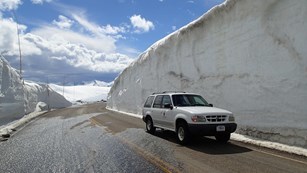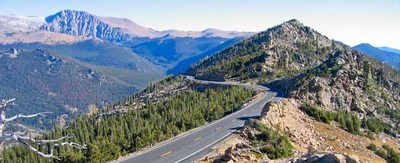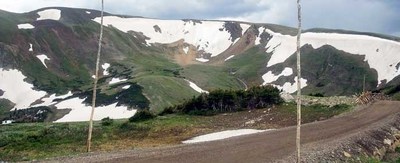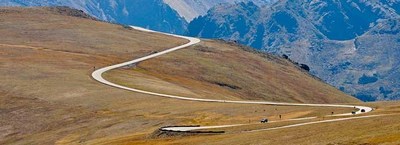Enjoy This Great Drive: The Roads Of Rocky Mountain National Park
Publishers Note: Twenty-two years ago when we first published the on-line version of The Auto Channel, there was no talk or even a thought (except for Jetson Fans) of ever having to consider giving up our freedom of mobility and the many pleasures of driving in exchange for a robotic ride controlled by a bundle of made in China silicon valley invented chips and a fear of a Heinlein-like implementation of a government controlled "Central Road Traffic Control Administration" that will have the mandate and technical ability to “make us safer” but eliminating our hard earned freedom of mobility.
Those of you who are regular readers of The Auto Channel know that for the past few years the geeks from the digital world, along with a mighty push from China and the backing of investment bankers plus misplaced enthusiasm of dumb politicians; have been pushing the adoption of electric "Autonomous Vehicles"..."transportation appliances" that will eliminate personal vehicle ownership and "Replace Driving with Riding".
In the hope to counter the overwhelming autonomous riding and EV propaganda, The Auto Channel management has decided to feature "The Auto Channel; Enjoy The Drive" editorial philosophy and spotlight Great Drives in Great Car articles with which to rekindle and stimulate the daydreams of experienced drivers and awaken the appetites of those modern youngsters who have never experienced just how exhilarating and fulfilling the freedom of a Great Drive in a Great Vehicle on an open road can be...enjoy!
Enjoy This Great Drive: The Roads Of Rocky Mountain National Park
SEE ALSO: CURRENT ROAD CONDITIONS AND ALERTS
SEE ALSO: LIVE ROCKY MOUNTAIN PARK WEBCAMS
The road system of Rocky Mountain National Park offers visitors access to diverse ecosystems characterizing the higher regions of the central Rocky Mountains. The roads take visitors through lowland meadows and aspen groves, along swift-flowing rivers and up through subalpine forests to more than 12,000 feet in elevation. No other national park roads offer the dramatic experience of a long drive across alpine tundra region, and few offer such a wide variety of experiences.
 |
The careful relationship of the park roads to the landscape results in a road system that generally harmonizes with the environment. Roadway alignments were chosen to highlight natural features, and scenic vistas and overlooks were provided to allow visitors to take in the magnificent terrain.
The stone parapet walls and road-related structures, constructed in the National Park Service's distinctive rustic style of architecture, relate well to their natural surroundings and help evoke a distinctive experience. Not surprisingly, the park roads are the principal attraction for most of the nearly three million visitors who flock to Rocky Mountain National Park each year.
Old Fall River Road
 |
Primarily gravel, one-way uphill and punctuated by switchbacks, slower-paced, 11-mile-long. The old road quietly leads travelers from Horseshoe Park (a short distance west of the Fall River Entrance) through the park's wilderness to Fall River Pass, 11,796 feet above sea level. The journey to the alpine world at the top of Old Fall River Road is relaxing. The experience is one to be savored.
The posted speed limit is 15 miles per hour, a clear indication that a journey up Old Fall River Road is not for the impatient. There are no guard rails along this road. The road itself is safe, but narrow and curved. In places, the trees of the montane and subalpine forests are so close that motorists can touch them. Old Fall River Road is ideal for visitors seeking to become intimate with nature.
The road follows a route traveled long ago by Indian hunters, who came to the park area in search of its abundant game. Early in the trip, travelers pass the alluvial fan scoured out by the 1982 Lawn Lake Flood and the site of a labor camp that housed state convicts who worked on the road project. For these men, crime did not pay. The laborers were forced to build the three-mile stretch of road to the scenic respite of Chasm Falls with no more than hand tools at their disposal.
After passing Willow Park, where elk often are seen feeding on the foliage, the road enters the alpine tundra. Awaiting there is the Fall River Cirque, birthplace of glaciers that once worked their way up and down the mountain valleys. The road traverses the headwall of this amphitheater-like formation before joining Trail Ridge Road near the Alpine Visitor Center at Fall River Pass.
Ahead lie the wonders of Trail Ridge Road, which leads travelers east to Estes Park or southwest to Grand Lake. Behind is Old Fall River Road, that winding old route that offers travelers a taste of auto travel in days gone by and a look at Rocky Mountain's nature close-up.
Trail Ridge Road
 |
The next year, Rocky Mountain National Park's lofty wilderness interior was introduced to the first travelers along an auto route the Rocky Mountain News called a "scenic wonder road of the world."
Was all this just enthusiastic exaggeration? Hardly.
Covering the 48 miles between Estes Park on the park's east side and Grand Lake on the west, Trail Ridge Road more than lives up to its advanced billing. Eleven miles of this high highway travel above treeline, the elevation near 11,500 feet where the park's evergreen forests come to a halt. As it winds across the tundra's vastness to its high point at 12,183 feet elevation, Trail Ridge Road (U.S. 34) offers visitors thrilling views, wildlife sightings and spectacular alpine wildflower exhibitions, all from the comfort of their car.
Whether they begin their journey at Estes Park or Grand Lake, Trail Ridge Road travelers climb some 4,000 feet in a matter of minutes. The changes that occur en route are fascinating to observe. A drive that may begin in montane forests of aspen and ponderosa pine soon enters thick subalpine forests of fir and spruce. At treeline, the last stunted, wind-battered trees yield to the alpine tundra.
Up on that windswept alpine world, conditions resemble those found in the Canadian or Alaskan Arctic. It's normally windy and 20 to 30 degrees colder than Estes Park or Grand Lake. The sun beats down with high- ultraviolet intensity. The vistas, best enjoyed from one of several marked road pullovers, are extravagant, sweeping north to Wyoming, east across the Front Range cities and Great Plains, south and west into the heart of the Rockies.
But for all its harshness, the Trail Ridge tundra is a place of vibrant life and vivid colors. Pikas, marmots, ptarmigans and bighorn sheep are commonly seen. About 200 species of tiny alpine plants hug the ground. Despite a growing season that may last just 40 days, many bloom exuberantly, adorning the green summer tundra with swatches of yellow, red, pink, blue, purple and white. All are seen from the Tundra World Nature Trail, a half-hour walk beginning near the parking area at Rock Cut.
Most Trail Ridge Road travelers drive to treeline with a certain amount of urgency. They are advised not to ignore all that awaits in the verdant country below the alpine tundra. Forested moraines, great heaps of earth and rock debris left behind by melting Ice Age glaciers, rise above lush mountain meadows. The Continental Divide, where streamflows are separated east from west, is crossed at Milner Pass, located at a surprisingly low 10,758 feet elevation. Moose munch greenery in the upper reaches of the Colorado River, which flows through the scenic Kawuneeche Valley. Grazing elk greet sunrise and sunset in many of the forest-rimmed meadows found around the park.
At all elevations, the drive on Trail Ridge Road is a memorable adventure. Put aside at least a half day for the trip. Longer, if possible. The experience, as Horace Albright suggested more than a half century ago, is hard to describe.
Trail Ridge Road is one of ten America's Byways in Colorado and a national designated All American Road. Like to see as many byways as you can? On the outskirts of Rocky is the oldest Colorado Scenic Byway, Peak to Peak, and another America's Byway, the Colorado River Headwaters. To learn more about other Colorado Scenic Byways click HERE
Thanks National Park Service
 |
The Rocky Pledge
“To preserve unimpaired for this and future generations the beauty, history, and wildness therein, I pledge to protect Rocky Mountain National Park.”
- To prevent fire scars and human-caused fires, I pledge to never build a fire outside of a campground or picnic area fire ring.
- To respect other visitors’ experiences, if I need to go but am not near a restroom, I pledge to leave no trace by stepping well away from the trail and water sources, burying my waste at least six inches deep or packing it out in a waste bag, and carrying out my toilet paper.
- To respect Rocky’s wild creatures and to protect myself, I pledge to watch wildlife from a distance that doesn’t disturb them in any way. I will never feed an animal—doing so causes it harm.
- To respect history, heritage, and natural processes, I pledge to remove nothing from the park except my own and others’ trash. I will leave no trace of my visit so that the next person can experience the same beauty as I did.
- To keep my pet, wildlife, and other visitors safe, I pledge to keep my leashed pet only on roads, in campgrounds, and in picnic and parking areas. I will never take my dog on Rocky’s trails, meadows, or tundra areas.
- To preserve them for the enjoyment, education, and inspiration of this and future generations, I pledge to honor, respect, and protect all our national parks and public lands.





